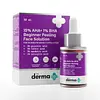What's inside
What's inside
 Key Ingredients
Key Ingredients

 Benefits
Benefits

 Concerns
Concerns

 Ingredients Side-by-side
Ingredients Side-by-side

Water
Skin ConditioningSorbitol
HumectantSodium Lauroamphoacetate
CleansingSodium C14-16 Olefin Sulfonate
CleansingJuglans Regia Shell Powder
AbrasivePropylene Glycol
HumectantCocamidopropyl Betaine
CleansingParfum
MaskingAcrylates/C10-30 Alkyl Acrylate Crosspolymer
Emulsion StabilisingLactobionic Acid
BufferingMandelic Acid
AntimicrobialCitrus Limon Fruit Extract
MaskingOryza Sativa Extract
AbsorbentButyrospermum Parkii Butter
Skin Conditioning1,2-Hexanediol
Skin ConditioningEuterpe Oleracea Pulp Powder
AbrasivePEG-40 Hydrogenated Castor Oil
EmulsifyingPerlite
AbsorbentXanthan Gum
EmulsifyingDisodium EDTA
Phenoxyethanol
PreservativePEG-45m
HumectantWater, Sorbitol, Sodium Lauroamphoacetate, Sodium C14-16 Olefin Sulfonate, Juglans Regia Shell Powder, Propylene Glycol, Cocamidopropyl Betaine, Parfum, Acrylates/C10-30 Alkyl Acrylate Crosspolymer, Lactobionic Acid, Mandelic Acid, Citrus Limon Fruit Extract, Oryza Sativa Extract, Butyrospermum Parkii Butter, 1,2-Hexanediol, Euterpe Oleracea Pulp Powder, PEG-40 Hydrogenated Castor Oil, Perlite, Xanthan Gum, Disodium EDTA, Phenoxyethanol, PEG-45m
Water
Skin ConditioningAloe Barbadensis Leaf Juice
Skin ConditioningGlycolic Acid
BufferingLactic Acid
BufferingMandelic Acid
AntimicrobialPropylene Glycol
HumectantCucurbita Pepo Seed Extract
Skin ConditioningSodium Hydroxide
BufferingSalicylic Acid
MaskingChamomilla Recutita Extract
Skin ConditioningPanthenol
Skin ConditioningCalendula Officinalis Flower Extract
MaskingSodium Hyaluronate
HumectantCamellia Sinensis Leaf Extract
AntimicrobialPhenoxyethanol
PreservativeChlorphenesin
AntimicrobialGlycerin
HumectantSodium Benzoate
MaskingDisodium EDTA
Water, Aloe Barbadensis Leaf Juice, Glycolic Acid, Lactic Acid, Mandelic Acid, Propylene Glycol, Cucurbita Pepo Seed Extract, Sodium Hydroxide, Salicylic Acid, Chamomilla Recutita Extract, Panthenol, Calendula Officinalis Flower Extract, Sodium Hyaluronate, Camellia Sinensis Leaf Extract, Phenoxyethanol, Chlorphenesin, Glycerin, Sodium Benzoate, Disodium EDTA
Ingredients Explained
These ingredients are found in both products.
Ingredients higher up in an ingredient list are typically present in a larger amount.
Disodium EDTA plays a role in making products more stable by aiding other preservatives.
It is a chelating agent, meaning it neutralizes metal ions that may be found in a product.
Disodium EDTA is a salt of edetic acid and is found to be safe in cosmetic ingredients.
Learn more about Disodium EDTAMandelic Acid is an alpha hydroxy acid (AHA).
Like other AHAs, it helps exfoliate the surface of the skin by breaking down the bonds that hold dead skin cells together. This helps reveal smoother and brighter skin underneath.
Mandelic acid helps with:
Due to it having a larger molecular size than glycolic acid, mandelic acid is able to penetrate the skin more slowly and evenly. This makes it gentler and less irritating, making it a great option for sensitive or beginner skin.
Despite being milder, mandelic acid is still an effective exfoliant that improves skin texture and tone over time.
What makes mandelic acid stand out from other AHAs? It has antibacterial and antioxidant properties.
These traits make it a great option for acne-prone or problem skin by reducing active breakouts and fading post-acne marks. Studies show that mandelic acid (especially when combined with salicylic acid) can significantly reduce pimples and hyperpigmentation while causing fewer side effects than stronger acids.
Mandelic acid is effective in concentrations of 5% and up with an ideal pH range of 3-4 for at-home use.
Like other AHAs, it’s important to wear sunscreen daily to protect your newly exfoliated skin.
However, unlike glycolic acid, mandelic acid is light-sensitive. Be sure your mandelic acid is packaged in opaque containers to ensure it stays stable and effective.
In short, mandelic acid is a gentle yet powerful AHA that exfoliates, brightens, and helps clarify skin while keeping irritation low. Its antibacterial action makes it especially beneficial for those with acne-prone, sensitive, or uneven skin, offering smoother, clearer, and more even-toned results over time.
Read more about some other popular AHA's here:
Learn more about Mandelic AcidPhenoxyethanol is a preservative that has germicide, antimicrobial, and aromatic properties. Studies show that phenoxyethanol can prevent microbial growth. By itself, it has a scent that is similar to that of a rose.
It's often used in formulations along with Caprylyl Glycol to preserve the shelf life of products.
Propylene Glycol is an odorless, colorless liquid. As a humectant, it helps skin retain moisture. It also aids in delivering active ingredients.
Another role of this ingredient is preventing a product from melting or freezing. Propylene glycol also adds antimicrobrial properties to a product, elongating product lifespan.
This ingredient is considered an organic alcohol and commonly added into both cosmetics and foods.
Those with sensitive skin or conditions may develop a rash when using this ingredient.
Learn more about Propylene GlycolWater. It's the most common cosmetic ingredient of all. You'll usually see it at the top of ingredient lists, meaning that it makes up the largest part of the product.
So why is it so popular? Water most often acts as a solvent - this means that it helps dissolve other ingredients into the formulation.
You'll also recognize water as that liquid we all need to stay alive. If you see this, drink a glass of water. Stay hydrated!
Learn more about Water